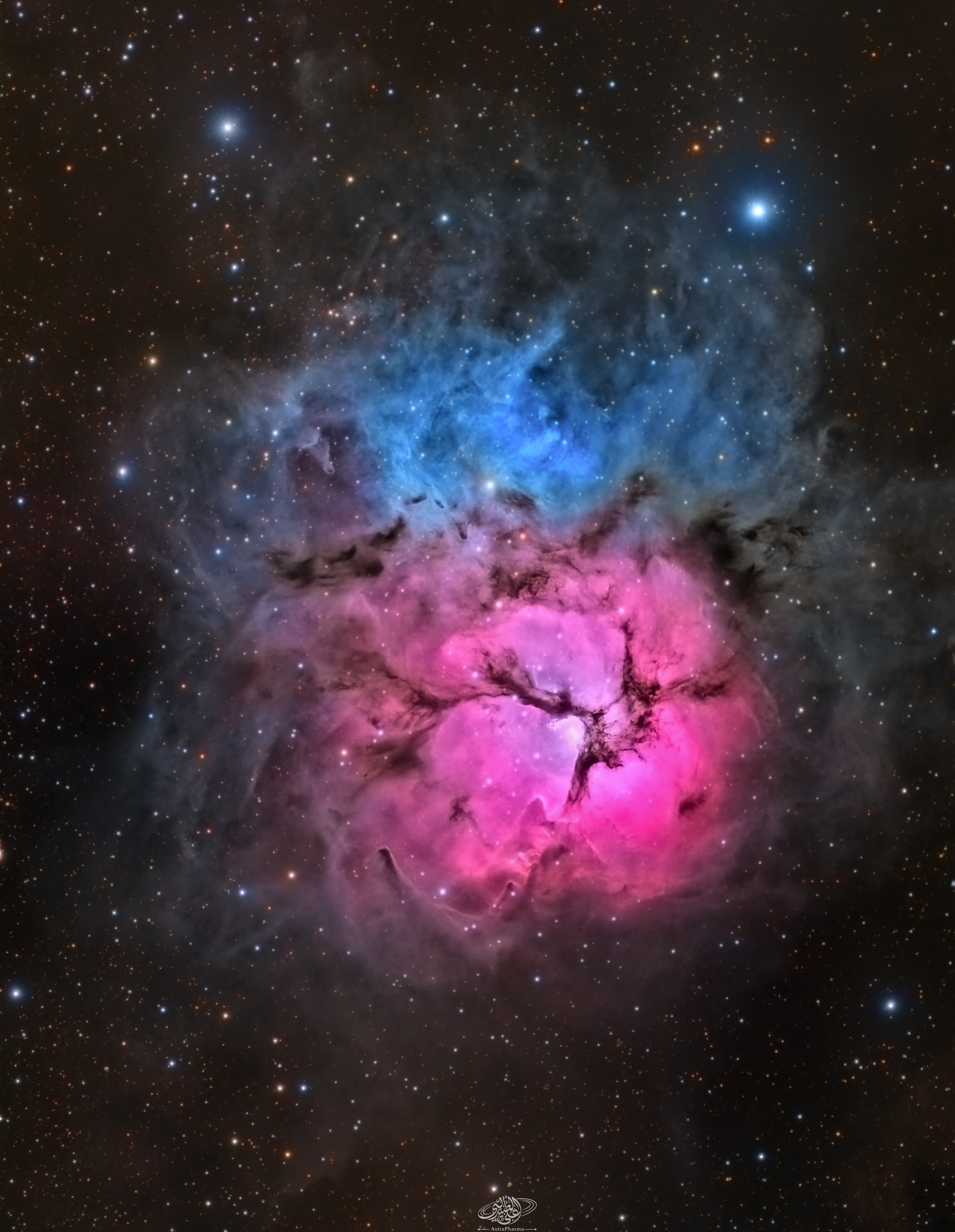 Trifid Nebula - M20
Trifid Nebula - M20 by
Ali Alobaidly, on Flickr
Trifid Nebula
https://www.astrobin.com/users/AstraPharma/
Copyright: Ali Alobaidly
Description:
The Trifid Nebula, also known as M20 or NGC 6514, is a beautiful and complex interstellar cloud located in the constellation Sagittarius. It is approximately 5,200 light years away from Earth and spans an area of about 40 light years in diameter.
The nebula is composed of a mix of gas and dust, with pink emission nebulae representing ionized hydrogen gas excited by hot, young stars and blue reflection nebulae reflecting the light of these same stars. The dark regions in the middle of the nebula are dust lanes that absorb light and make it difficult to see deeper into the cloud where new stars are forming.
In addition to its stunning visual appearance, the Trifid Nebula is also a site of active star formation. Within the nebula, there are several regions where new stars are being born - known as Bok globules - which are dense clouds of gas and dust that are collapsing under their own gravity.
With this project my focus was on learning and improving my Pixinsight stretching skills, experimenting with more sophisticated tools like arcsinh and masked stretching. I was struggling to keep the stars at bay for whatever reason and when I had them in a more desirable shape and size the contrast within the nebulosity had other plans. Using a combination of different stretching methods I came up with this!
Acquisition details:
Gain 100 (Session 1) - Gain 0 (Session 2) - Sensor temperature (0°C)
Dates: June 16, 2023 · June 23, 2023
Frames:
Chroma Blue 36 mm: 20×180″(1h)
Chroma Green 36 mm: 20×180″(1h)
Chroma Lum 36 mm: 60×180″(3h)
Chroma Red 36 mm: 20×180″(1h)
Total Integration: 6h
Avg. Moon age: 16.38 days
Avg. Moon phase: 13.57%
Equipment:
Telescope: Celestron EdgeHD 9.25"
Camera: ZWO ASI2600MM Pro
Mounts: Sky-Watcher EQ6-R Pro + Sky-Watcher EQ8-R Pro
Filters:
-Chroma Blue 36 mm
-Chroma Green 36 mm
-Chroma Luminance 36 mm ·
Chroma Red 36 mm
Accessories:
-Celestron 0.7X Reducer EdgeHD925
-ZWO EFW 7 x 36mm
[url=https://flic.kr/p/2oKK8DX][img]https://live.staticflickr.com/65535/53003566333_c4a4d9784d_k.jpg[/img][/url][url=https://flic.kr/p/2oKK8DX]Trifid Nebula - M20[/url] by [url=https://www.flickr.com/photos/197985535@N06/]Ali Alobaidly[/url], on Flickr
Trifid Nebula
https://www.astrobin.com/users/AstraPharma/
Copyright: Ali Alobaidly
Description:
The Trifid Nebula, also known as M20 or NGC 6514, is a beautiful and complex interstellar cloud located in the constellation Sagittarius. It is approximately 5,200 light years away from Earth and spans an area of about 40 light years in diameter.
The nebula is composed of a mix of gas and dust, with pink emission nebulae representing ionized hydrogen gas excited by hot, young stars and blue reflection nebulae reflecting the light of these same stars. The dark regions in the middle of the nebula are dust lanes that absorb light and make it difficult to see deeper into the cloud where new stars are forming.
In addition to its stunning visual appearance, the Trifid Nebula is also a site of active star formation. Within the nebula, there are several regions where new stars are being born - known as Bok globules - which are dense clouds of gas and dust that are collapsing under their own gravity.
With this project my focus was on learning and improving my Pixinsight stretching skills, experimenting with more sophisticated tools like arcsinh and masked stretching. I was struggling to keep the stars at bay for whatever reason and when I had them in a more desirable shape and size the contrast within the nebulosity had other plans. Using a combination of different stretching methods I came up with this!
Acquisition details:
Gain 100 (Session 1) - Gain 0 (Session 2) - Sensor temperature (0°C)
Dates: June 16, 2023 · June 23, 2023
Frames:
Chroma Blue 36 mm: 20×180″(1h)
Chroma Green 36 mm: 20×180″(1h)
Chroma Lum 36 mm: 60×180″(3h)
Chroma Red 36 mm: 20×180″(1h)
Total Integration: 6h
Avg. Moon age: 16.38 days
Avg. Moon phase: 13.57%
Equipment:
Telescope: Celestron EdgeHD 9.25"
Camera: ZWO ASI2600MM Pro
Mounts: Sky-Watcher EQ6-R Pro + Sky-Watcher EQ8-R Pro
Filters:
-Chroma Blue 36 mm
-Chroma Green 36 mm
-Chroma Luminance 36 mm ·
Chroma Red 36 mm
Accessories:
-Celestron 0.7X Reducer EdgeHD925
-ZWO EFW 7 x 36mm